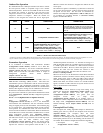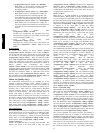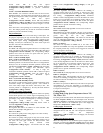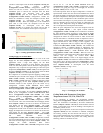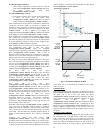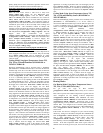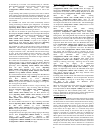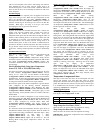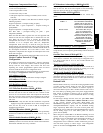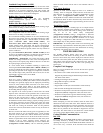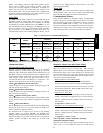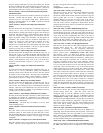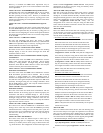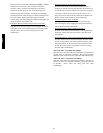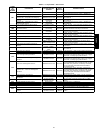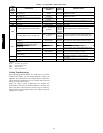
23
Temperature Compensated Start Logic
The following conditions must be met for the algorithm to run:
S Unit is in unoccupied state.
S Next occupied time is valid.
S Current time of day is valid.
S Valid space temperature reading is available (sensor or CCN
network).
The algorithm will calculate a Start Bias time in minutes using the
following equations:
If (space temperature > occupied cooling set point)
Start Bias Time = (space temperature -- occupied cooling set
point)*TCS.C
If (space temperature < occupied heating set point)
Start Bias Time = (occupied heating set point -- space
temperature)*TCS.H
When the Start Bias Time is greater than zero the algorithm will
subtract it from the next occupied time to calculate the new start
time. W hen the new start time is reached, the Temperature
Compensated Start mode is set, the fan is started and the unit
controlled as in an occupied state. Once set, Temperature
Compensated mode will stay on until the unit goes into the
Occupied mode. The Start Bias Time will be written into t he CCN
Linkage Equipment Table if the unit is controlled in DAV mode. If
the Unoccupied Economizer Free Cool mode is activ e when
temperature compensated start begins, the Unoccupied Free Cool
mode will be stopped.
IMPORTANT: The maximum minutes Start Bias can be is 180.
Carrier Comfort Network (CCN)R
Configuration
It is possible to configure the ComfortLink™ control to participate
as an element of the Carrier Comfort Network (CCN) system
directly from the local display. This section will deal with
explaining the various programmable options which are found
under the CCN sub-menu in the Configuration mode.
The major configurations for CCN programming are located in the
local displays at Configuration→CCN. See Appendix A.
CCN Address (CCN.A)
This configuration is the CCN address the rooftop is assigned.
CCN Address (CCN.B)
This configuration is the CCN bus the rooftop is assigned.
CCN Baud Rate (BAUD)
This configuration is the CCN baud rate.
CCN Time/Date Broadcast (BROD→B.TIM)
If this configuration is set to ON, the control will periodically send
the time and date out onto the CCN bus once a minute. If this
device is on a CCN network then it will be important to make sure
that only one device on the bus has this configuration set to ON. If
more than one time broadcaster i s present, problems with the time
will occur.
IMPORTANT: Only the time and date broadcaster can perform
daylight savings time adjustments. Even if the rooftop is stand
alone, the user may want to set this to ON to accomplish the
daylight/savings function.
CCN OAT Broadcast (BROD→B.OAT)
If this configuration is set to ON, the control will periodically
broadcast its outside-air temperature at a rate of once every 30
minutes.
Global Schedule B r oadcast (BROD→B.GS)
If this configuration is set to ON and the schedule number
(SCH.N) is between 65 and 99, then the control will broadcast the
internal time schedule once every 2 minutes.
CCN Broadcast Acknowledger (BROD→B.ACK)
If this configuration is set to ON, then when any broadcasting is
done on the bus, this device will respond to and acknowledge.
Only one device per bus can be configured for this option.
Schedule N umber (SCH.O→SCH.N)
This configuration determines what schedule the control may
follow.
SCH.N = 0 The control is always occup ied.
SCH.N = 1 The control f ollows its in ternal time
schedules. The user may enter any
number between 1 and 64 but it will
be overwritten to “1” by the c ontr ol
as it only has one internal schedule.
SCH.N = 65--99 The control is eith er set up to
receive to a b roadcast ed time
schedule set to this number or the
control is set up to br oadcast its
internal time schedule (B.G S)tothe
network and this is the global
schedule number it is b roadcasting.
If this is the case, then the control
st ill follows its i n t ern al time
schedules.
Accept Global Holidays? (SCH.O→HOL.G)
If a device is broadcasting the time on the bus, it is possible to
accept the time yet not accept the global holiday from the broadcast
message.
Override Time Limit (SCH.O→OV.TL)
This configuration allows the user to decide how long an override
occurs when it is initiated. The override may be configured from 1
to 4 hours. If the time is set to 0, the override function will
become disabled.
Timed Override Hours (SCH.O→OV.EX)
This displays the current number of hours left in an override. It is
possible to cancel an override in progress by writing “0” to this
variable, thereby removing the override time left.
SPT Override Enabled? (SCH.O→OV.SP)
If a space sensor is present, then it is possible to override an
unoccupied period by pushing the override button on the T55 or
T56 sensor. This option allows the user to disable this function by
setting this configuration to NO.
Demand Limit
Demand Limit Control may override the cooling algorithm to limit
or reduce cooling capacity during run time. The term Demand
Limit Control refers to the restriction of machine capacity to
control the amount of power that a machine will use. This can save
the owner money by limiting peaks in t he power s upply. Demand
limit control is intended to interface with an external network
system. This is through a CCN Loadshed POC Device or writing
to network points.
To limit stages through network writes, the points Run Status
→COOL→MAX.C and Run Status→HEAT→MAX.H are forced
on the network through CCN points MAX_CAPC and
MAXHSTGS respectively. Force these to the desired max imum
cooling/dehumidification capacity and the maximum heating
stages, respectively. When there is no force on these points, they
automatically reset to allow full cooling/dehumidification capacity
and all heating stages to be used. These points are reset at
power--on/reset (POR).
When using the Loadshed POC to do Demand Limiting, the c ool
capacity and heat stage limits under both Redline and Loadshed
conditions can be set individually with configuration decisions. If
the active stages are greater then the loadshed or redline
configurations when a loadshed or redline command is given, the
unit will reduce capacity or remove stages. The configuration
points can be found in Configuration→CCN→LDS.
48/50PD



